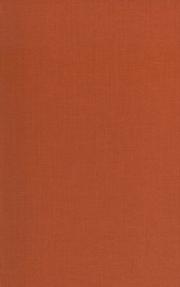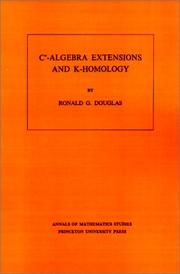| Listing 1 - 8 of 8 |
Sort by
|
Book
ISBN: 0444802185 Year: 1980 Publisher: Amsterdam
Abstract | Keywords | Export | Availability | Bookmark
 Loading...
Loading...Choose an application
- Reference Manager
- EndNote
- RefWorks (Direct export to RefWorks)
Chemistry of natural organic substances --- Amino acid sequence --- Peptides --- Proteins --- Solid-phase analysis --- Congresses. --- Analysis --- Protein sequence analysis
Book
Abstract | Keywords | Export | Availability | Bookmark
 Loading...
Loading...Choose an application
- Reference Manager
- EndNote
- RefWorks (Direct export to RefWorks)
Sequence controllers, Programmable --- Industries --- Automatismes séquentiels. --- GRAFCET. --- Industrie --- Data processing. --- Informatique.
Book
ISBN: 3540097295 3642455158 9783540097297 Year: 1980 Volume: 173 Publisher: Berlin Springer
Abstract | Keywords | Export | Availability | Bookmark
 Loading...
Loading...Choose an application
- Reference Manager
- EndNote
- RefWorks (Direct export to RefWorks)
Transport. Traffic --- Operational research. Game theory --- Transportation planning --- Mathematical optimization --- Mathematical models --- 658.512 --- Production plan, schedule. Determination of sequence of operations (sequencing). Routeing --- Management --- Sociology & Social History --- Social Sciences --- Business & Economics --- Management Theory --- Communities - Urban Groups --- 658.512 Production plan, schedule. Determination of sequence of operations (sequencing). Routeing --- Transportation planning - Mathematical models --- Transportation planning process --- Transportation planning(Mathematical Models)

ISBN: 0520080416 0585359261 Year: 1980 Publisher: Berkeley : University of California Press,
Abstract | Keywords | Export | Availability | Bookmark
 Loading...
Loading...Choose an application
- Reference Manager
- EndNote
- RefWorks (Direct export to RefWorks)
Students --- Academic achievement --- Family size --- Birth order --- Cost and standard of living --- Social conditions --- Comfort, Standard of --- Cost of living --- Food, Cost of --- Household expenses --- Living, Cost of --- Living, Standard of --- Standard of living --- Consumption (Economics) --- Home economics --- Households --- Quality of life --- Wealth --- Luxury --- Prices --- Purchasing power --- Wages --- Order, Birth --- Sequence, Sibling --- Sibling sequence --- Families --- First-born children --- Second-born children --- Youngest child --- Size of families --- Family planning --- Pupils --- School life --- Student life and customs --- Persons --- Education --- Surveys --- Psychological aspects
Book
ISBN: 9028905111 Year: 1980 Publisher: Antwerpen De Sikkel
Abstract | Keywords | Export | Availability | Bookmark
 Loading...
Loading...Choose an application
- Reference Manager
- EndNote
- RefWorks (Direct export to RefWorks)
demografie --- Sociology of the family. Sociology of sexuality --- gezinssociologie --- Belgium --- 311:314 --- Birth order --- -Family size --- -Fertility, Human --- -kinderwens --- seksualiteit --- contraceptie --- #SBIB:314H233 --- #GSDBP --- #gsdb5 --- 314.33 --- 312.1 --- $?$7/87 --- #C2000 --- 659 Demografie --- Gezin --- Gezinsplanning --- Human fertility --- Natality --- Demography --- Human reproduction --- Infertility --- Size of families --- Family planning --- Order, Birth --- Sequence, Sibling --- Sibling sequence --- Families --- First-born children --- Second-born children --- Youngest child --- Bevolkingsstatistieken. Demografische statistieken --- 159.92 --- 392.6 --- 179.7 --- Geboorteregeling --- Famille --- Planning familial --- Psychological aspects --- Family size --- Fertility, Human --- Pedagogiek en onderwijskunde --- gezinspedagogiek --- 311:314 Bevolkingsstatistieken. Demografische statistieken --- gezinspedagogiek. --- Gezinspedagogiek. --- kinderwens --- Démographie --- Flandre --- Family --- Book --- Démographie
Book
ISBN: 0913232890 Year: 1980 Publisher: Los Altos Kaufmann
Abstract | Keywords | Export | Availability | Bookmark
 Loading...
Loading...Choose an application
- Reference Manager
- EndNote
- RefWorks (Direct export to RefWorks)
Geological time --- Plate tectonics --- Rocks, Igneous --- Eruptive rocks --- Igneous petrology --- Igneous rocks --- Petrology, Igneous --- Rocks, Eruptive --- Rocks --- Tectonics, Plate --- Geodynamics --- Age of rocks --- Geochronology --- Geochrony --- Time, Geological --- Chronology --- Historical geology --- Sequence stratigraphy --- Petrology --- Age --- Earth --- Earth (Planet) --- DATATIONS --- GENERALITES --- SCIENCES DE LA TERRE --- VOLCANOLOGIE --- GEOPHYSIQUE --- GEODYNAMIQUE --- ISOSTASIE, DERIVE DES CONTINENTS, PLAQUES...

ISBN: 0691082383 1400883989 Year: 1980 Publisher: Princeton, N.J.
Abstract | Keywords | Export | Availability | Bookmark
 Loading...
Loading...Choose an application
- Reference Manager
- EndNote
- RefWorks (Direct export to RefWorks)
One of the most important mathematical achievements of the past several decades has been A. Grothendieck's work on algebraic geometry. In the early 1960s, he and M. Artin introduced étale cohomology in order to extend the methods of sheaf-theoretic cohomology from complex varieties to more general schemes. This work found many applications, not only in algebraic geometry, but also in several different branches of number theory and in the representation theory of finite and p-adic groups. Yet until now, the work has been available only in the original massive and difficult papers. In order to provide an accessible introduction to étale cohomology, J. S. Milne offers this more elementary account covering the essential features of the theory. The author begins with a review of the basic properties of flat and étale morphisms and of the algebraic fundamental group. The next two chapters concern the basic theory of étale sheaves and elementary étale cohomology, and are followed by an application of the cohomology to the study of the Brauer group. After a detailed analysis of the cohomology of curves and surfaces, Professor Milne proves the fundamental theorems in étale cohomology -- those of base change, purity, Poincaré duality, and the Lefschetz trace formula. He then applies these theorems to show the rationality of some very general L-series.Originally published in 1980.The Princeton Legacy Library uses the latest print-on-demand technology to again make available previously out-of-print books from the distinguished backlist of Princeton University Press. These editions preserve the original texts of these important books while presenting them in durable paperback and hardcover editions. The goal of the Princeton Legacy Library is to vastly increase access to the rich scholarly heritage found in the thousands of books published by Princeton University Press since its founding in 1905.
Ordered algebraic structures --- 512.73 --- 512.66 --- Geometry, Algebraic --- Homology theory --- Sheaf theory --- Cohomology, Sheaf --- Sheaf cohomology --- Sheaves, Theory of --- Sheaves (Algebraic topology) --- Algebraic topology --- Cohomology theory --- Contrahomology theory --- Algebraic geometry --- Geometry --- Cohomology theory of algebraic varieties and schemes --- Homological algebra --- Geometry, Algebraic. --- Homology theory. --- Sheaf theory. --- 512.66 Homological algebra --- 512.73 Cohomology theory of algebraic varieties and schemes --- Abelian category. --- Abelian group. --- Adjoint functors. --- Affine variety. --- Alexander Grothendieck. --- Algebraic closure. --- Algebraic cycle. --- Algebraic equation. --- Algebraic space. --- Algebraically closed field. --- Artinian. --- Automorphism. --- Base change. --- Brauer group. --- CW complex. --- Cardinal number. --- Category of sets. --- Central simple algebra. --- Chow's lemma. --- Closed immersion. --- Codimension. --- Cohomology ring. --- Cohomology. --- Cokernel. --- Commutative diagram. --- Complex number. --- Dedekind domain. --- Derived category. --- Diagram (category theory). --- Direct limit. --- Discrete valuation ring. --- Divisor. --- Epimorphism. --- Equivalence class. --- Existential quantification. --- Fibration. --- Field of fractions. --- Fine topology (potential theory). --- Finite field. --- Finite morphism. --- Flat morphism. --- Functor. --- Fundamental class. --- Fundamental group. --- G-module. --- Galois cohomology. --- Galois extension. --- Galois group. --- Generic point. --- Group scheme. --- Gysin sequence. --- Henselian ring. --- Identity element. --- Inclusion map. --- Integral domain. --- Intersection (set theory). --- Inverse limit. --- Invertible sheaf. --- Isomorphism class. --- Lefschetz pencil. --- Local ring. --- Maximal ideal. --- Module (mathematics). --- Morphism of schemes. --- Morphism. --- Noetherian. --- Open set. --- Power series. --- Presheaf (category theory). --- Prime ideal. --- Prime number. --- Principal homogeneous space. --- Profinite group. --- Projection (mathematics). --- Projective variety. --- Quasi-compact morphism. --- Residue field. --- Riemann surface. --- Sheaf (mathematics). --- Sheaf of modules. --- Special case. --- Spectral sequence. --- Stein factorization. --- Subalgebra. --- Subcategory. --- Subgroup. --- Subring. --- Subset. --- Surjective function. --- Tangent space. --- Theorem. --- Topological space. --- Topology. --- Torsion sheaf. --- Torsor (algebraic geometry). --- Vector bundle. --- Weil conjecture. --- Yoneda lemma. --- Zariski topology. --- Zariski's main theorem. --- Geometrie algebrique --- Cohomologie

ISBN: 0691082650 0691082669 1400881463 Year: 1980 Publisher: Princeton, N.J.
Abstract | Keywords | Export | Availability | Bookmark
 Loading...
Loading...Choose an application
- Reference Manager
- EndNote
- RefWorks (Direct export to RefWorks)
Recent developments in diverse areas of mathematics suggest the study of a certain class of extensions of C*-algebras. Here, Ronald Douglas uses methods from homological algebra to study this collection of extensions. He first shows that equivalence classes of the extensions of the compact metrizable space X form an abelian group Ext (X). Second, he shows that the correspondence X ⃗ Ext (X) defines a homotopy invariant covariant functor which can then be used to define a generalized homology theory. Establishing the periodicity of order two, the author shows, following Atiyah, that a concrete realization of K-homology is obtained.
Analytical spaces --- 517.986 --- Topological algebras. Theory of infinite-dimensional representations --- Algebra, Homological. --- C*-algebras. --- K-theory. --- 517.986 Topological algebras. Theory of infinite-dimensional representations --- Algebra, Homological --- C*-algebras --- K-theory --- Algebraic topology --- Homology theory --- Algebras, C star --- Algebras, W star --- C star algebras --- W star algebras --- W*-algebras --- Banach algebras --- Homological algebra --- Algebra, Abstract --- K-théorie. --- Homologie. --- Addition. --- Affine transformation. --- Algebraic topology. --- Atiyah–Singer index theorem. --- Automorphism. --- Banach algebra. --- Bijection. --- Boundary value problem. --- Bundle map. --- C*-algebra. --- Calculation. --- Cardinal number. --- Category of abelian groups. --- Characteristic class. --- Chern class. --- Clifford algebra. --- Coefficient. --- Cohomology. --- Compact operator. --- Completely positive map. --- Contact geometry. --- Continuous function. --- Corollary. --- Diagram (category theory). --- Diffeomorphism. --- Differentiable manifold. --- Differential operator. --- Dimension (vector space). --- Dimension function. --- Dimension. --- Direct integral. --- Direct proof. --- Eigenvalues and eigenvectors. --- Equivalence class. --- Equivalence relation. --- Essential spectrum. --- Euler class. --- Exact sequence. --- Existential quantification. --- Fiber bundle. --- Finite group. --- Fredholm operator. --- Fredholm. --- Free abelian group. --- Fundamental class. --- Fundamental group. --- Hardy space. --- Hermann Weyl. --- Hilbert space. --- Homological algebra. --- Homology (mathematics). --- Homomorphism. --- Homotopy. --- Ideal (ring theory). --- Inner automorphism. --- Irreducible representation. --- K-group. --- Lebesgue space. --- Locally compact group. --- Maximal compact subgroup. --- Michael Atiyah. --- Monomorphism. --- Morphism. --- Natural number. --- Natural transformation. --- Normal operator. --- Operator algebra. --- Operator norm. --- Operator theory. --- Orthogonal group. --- Pairing. --- Piecewise linear manifold. --- Polynomial. --- Pontryagin class. --- Positive and negative parts. --- Positive map. --- Pseudo-differential operator. --- Quaternion. --- Quotient algebra. --- Self-adjoint operator. --- Self-adjoint. --- Simply connected space. --- Smooth structure. --- Special case. --- Stein manifold. --- Strong topology. --- Subalgebra. --- Subgroup. --- Subset. --- Summation. --- Tangent bundle. --- Theorem. --- Todd class. --- Topology. --- Torsion subgroup. --- Unitary operator. --- Universal coefficient theorem. --- Variable (mathematics). --- Von Neumann algebra. --- Homology theory. --- Homologie --- K-théorie --- C etoile-algebres
| Listing 1 - 8 of 8 |
Sort by
|

 Search
Search Feedback
Feedback About UniCat
About UniCat  Help
Help News
News